Historical Summary:
The following is excerpted from the June 2012 CYA Newsletter, Classic Yachting:
PNW Fleet Report -- Suellen
by John & Jane Lebens, PNW Fleet Members
Most of you know what it's like when you buy an old wooden boat - one thing leads to another. . .
Here is the short story of our happy adventure as first-time wooden boat owners. Like many of us, Jane and I began by walking docks and attending boat shows. For a while we thought a Grand Banks or similar boat would fit our needs. But a funny thing happened one day on a dock on the Columbia River in Portland. We spotted a late 1940s troller nicely converted to a cruising yacht. At that moment we fell in love with the wooden boat aesthetic and never really looked back.
Eventually Suellen appeared on a computer search and was located at a nearby marina. She is an Ed Monk Sr. design from about 1938. She had been boathouse kept. As we looked her over, she appeared to be in good condition. The price was OK. Of course there would be a few items needing attention. The survey showed her to be sound of hull, house, and engine, but recommended a few dozen "small" fixes. We were encouraged when we overheard our normally taciturn surveyor, Alison Mazon, say the hull was "marvelous."
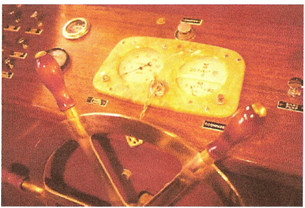 Like many a new owner, we dove into our new project with gusto. The first winter, we completed all the items recommended in the survey. You know all about "minor" fixes on a woodie, That minor 110 volt wiring issue mentioned in the survey? To really fix it, we pulled out all the old 110 system and replaced it with new. The apparently simple installation of a pair of 12 volt switches? We replaced the 12 volt system as well. One thing lead to another and she is now ABYC compliant with new wiring, fuses, batteries, alternator, starter, etc. That original copper plumbing was nice, but it was it beat up, so we decided to re-plumb her. Of course we kept the porcelain sink from 1944, and we located a faucet that was a dead ringer for the original. The engine needed a new exhaust riser, and dual Racor filters seemed like a good idea. The hull got a fine fresh coat of paint, and the list went on.
Like many a new owner, we dove into our new project with gusto. The first winter, we completed all the items recommended in the survey. You know all about "minor" fixes on a woodie, That minor 110 volt wiring issue mentioned in the survey? To really fix it, we pulled out all the old 110 system and replaced it with new. The apparently simple installation of a pair of 12 volt switches? We replaced the 12 volt system as well. One thing lead to another and she is now ABYC compliant with new wiring, fuses, batteries, alternator, starter, etc. That original copper plumbing was nice, but it was it beat up, so we decided to re-plumb her. Of course we kept the porcelain sink from 1944, and we located a faucet that was a dead ringer for the original. The engine needed a new exhaust riser, and dual Racor filters seemed like a good idea. The hull got a fine fresh coat of paint, and the list went on.
In our spare time we started sleuthing prior owners. We were especially interested in the original owner and builder. The Coast Guard documentation listed him as Louis A. Hascall, Master Carpenter. Searching the web and cold calling everyone named "Hascall" in the Seattle area, we finally hit gold when Patrick, the great grandson of the builder, picked up the phone. He vividly remembered visiting his great grandfather's shop as a kid. He recalled Grandpa Lou was a kind man. He insisted we call his Auntie Sue. Suellen (herself) was delighted to hear the news that her namesake vessel was still being cared for. She had recently been looking at old photos and wondered what had become of grandpa's boat. She promised to send photos of the christening and launch from the Spring of 1951.
|
Louis A. Hascall launching Suellen in 1951 |
We learned from Suellen that Grandpa Lou built boats for a living and that Suellen was one of two that he built for himself He laid the keel just before World War II, then progress slowed during the war. Louis was employed at the Puget Sound Naval Shipyard during the war and afterwards at Blanchard Boat Company on Lake Union in Seattle.
With a few more clues in hand, we contacted the Puget Sound Maritime Historical Society to see what more we could learn. We hit another jackpot with John Kelly, volunteer Ship Plans Curator. John is about 90 years old and sharp as a tack. He told us he knew where Suellen was built and invited us to come up and see. It turns out that John grew up about three blocks from the Hascall residence. As an adult, he used the same marina on the Duwamish River that Hascall used. With the current resident's permission he took us to the former Hascall home. There we could clearly see from original photos that it was the backyard where she was built. An older neighbor across the street recalled the vessel. Later, John showed us a photo of himself in 1939 at the Edison Technical Institute learning to build boats. He was peering out from the frames of Suellen's sistership, Lady Grace - a current CY A member.
Call us crazy, but we decided to take Suellen up to Puget Sound for the summer of 2009. We cruised about 100 miles down the Columbia River to Astoria, over the Columbia River bar, 170 miles up the coast to Neah Bay, then into Port Angeles. We rested! Then we crossed the Strait of Juan de Fuca, through Cattle Pass and in to Friday Harbor. There we spent an idyllic summer, hung out with other wood boat owners, and lived the boating dream. Did I mention that I had never been in a small boat on the ocean? Did I mention this is a 60 year old boat with a 30 year old engine? Well we did learn a few things, were never in real danger, and all's well that ends well. And "The Bar" was like a lake.
That summer, Suellen (herself), her brother Robert and other family members, came to Friday Harbor to see their grandfather's masterpiece once again. It had been nearly 60 years since they last saw her. We had a marvelous rechristening ceremony and a cruise around the harbor with friends and relatives on board. There were tears of joy and remembrance when Father Anderson delivered a fine homily about how this vessel brings people closer together.
That summer, I began to notice the varnish on Suellen's fine mahogany house was looking tired and faded. I wondered what she would look like with a fresh finish. We were warned by Frank Bender, proud owner with his wife LaRue, of a classic motor sailor. He said "don't do it! Just keep varnish on and she'll be OK" I had no clue what I was getting into.
Fast forward through two and a half years of hard (and often satisfying) labor. I could write a treatise on the technical and spiritual aspects of refinishing mahogany. I now consider myself to be an authority on sandpaper and sanding devices, chemical stripping and stripping tools, wood conditioning and staining and the evils of epoxy sealer coats. And varnish! At least ten coats from bare wood, then two coats every year for the rest of your life. It was a huge and time consuming job. But the results gained from months of hard work are ample repayment.
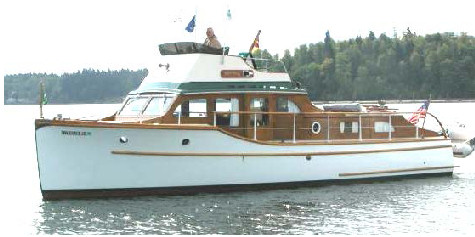 Most CYA members who used to see Suellen were full of compliments. "What a fine vessel she is," they would say. But then: "who put on that bridge?" This fine vessel deserved to be a regular member of CY A, not an affiliate. Lew Barrett was a friend and the PNW Fleet Commodore so I asked him to pull some strings and use his influence but he had no authority to do that. I pitched Margie Paynton, but she replied that she couldn't change the rules. I complained to fellow CYA members. They listened politely. Finally, we decided to take off that offending 1970s bridge. Mike Keane and David Wisdom, men of action and CY A members, said "let's demo it!" We scheduled a couple of mornings to do the job but the bridge was off by noon the first day. Standing back, we immediately saw the wisdom of the choice. The original Monk proportions and fine lines were revealed. Hascall's masterfully made compound curves were on display once again. The ugly bridge was gone. Margie warmed. Ann Hay cooed. We got the blue burgee and we got the brass plaque.
Most CYA members who used to see Suellen were full of compliments. "What a fine vessel she is," they would say. But then: "who put on that bridge?" This fine vessel deserved to be a regular member of CY A, not an affiliate. Lew Barrett was a friend and the PNW Fleet Commodore so I asked him to pull some strings and use his influence but he had no authority to do that. I pitched Margie Paynton, but she replied that she couldn't change the rules. I complained to fellow CYA members. They listened politely. Finally, we decided to take off that offending 1970s bridge. Mike Keane and David Wisdom, men of action and CY A members, said "let's demo it!" We scheduled a couple of mornings to do the job but the bridge was off by noon the first day. Standing back, we immediately saw the wisdom of the choice. The original Monk proportions and fine lines were revealed. Hascall's masterfully made compound curves were on display once again. The ugly bridge was gone. Margie warmed. Ann Hay cooed. We got the blue burgee and we got the brass plaque.
We had noticed in the documentation that Suellen, then called Kittiwake, had spent the 1960s in Astoria. She was owned by a man named Rolf Klep, the founder of the Columbia River Maritime Museum. He's a local legend in Astoria. We learned that CYA member Sam Johnson, the current museum director, owns a classic wood vessel called Winikin and we are pretty sure' it's Hascall's other boat, launched in 1933.
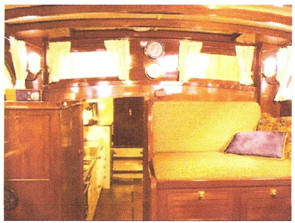 Richard and Nancy Carruthers owned Suellen after the Kleps. They are still in Astoria and have generously shared photos and stories. Klep told them Hascall set aside some of the best wood passing through the Blanchard Boat Company for use on Suellen. It could very well be. Most of her Alaska yellow cedar planks run the full length of the hull. The house is built of solid inch and a half clear Honduran mahogany. The transom is teak. We set out on a fine course when we came to own Suellen. After three and a half years, this wooden vessel has led us through all sorts of adventures. We have been surrounded by many helpful and supportive wooden boat owners, especially Classic Yacht Association members. We appreciate the fine marine technicians who have kept us up to ABYC standards. We are in awe of the craftsmanship that went in to building this vessel and the care prior owners have lavished on it. We have a satisfying project that is repaying our efforts and investment. We learned a lot of Pacific NW maritime history ranging from vessel design and construction to maritime adventures.
Richard and Nancy Carruthers owned Suellen after the Kleps. They are still in Astoria and have generously shared photos and stories. Klep told them Hascall set aside some of the best wood passing through the Blanchard Boat Company for use on Suellen. It could very well be. Most of her Alaska yellow cedar planks run the full length of the hull. The house is built of solid inch and a half clear Honduran mahogany. The transom is teak. We set out on a fine course when we came to own Suellen. After three and a half years, this wooden vessel has led us through all sorts of adventures. We have been surrounded by many helpful and supportive wooden boat owners, especially Classic Yacht Association members. We appreciate the fine marine technicians who have kept us up to ABYC standards. We are in awe of the craftsmanship that went in to building this vessel and the care prior owners have lavished on it. We have a satisfying project that is repaying our efforts and investment. We learned a lot of Pacific NW maritime history ranging from vessel design and construction to maritime adventures.
Oh, and we've learned way too much about stripping finishes and sanding wood and varnishing!
We will see where the course leads us next.
Owner's Photos:
Photos by Bob Huff Photo, except where indicated.
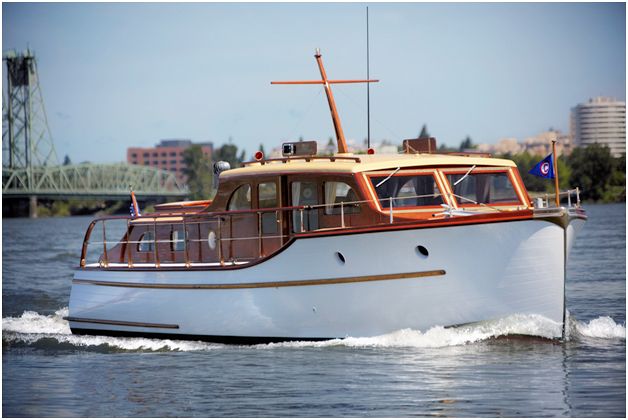
Suellen cruising on the Columbia River
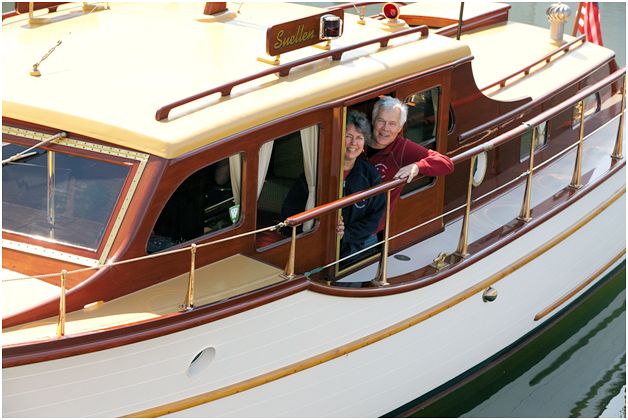
Owners John & Jane Lebens
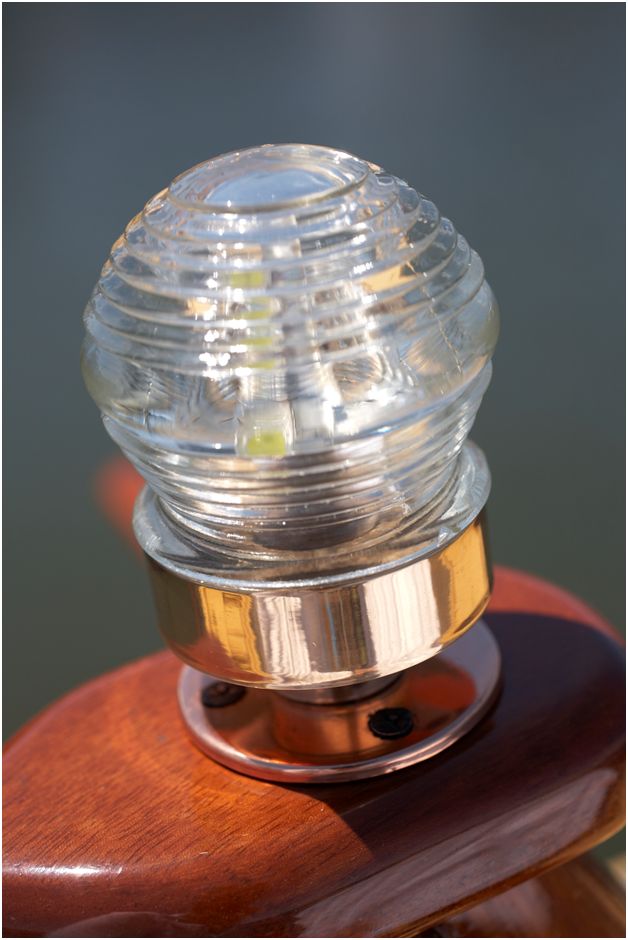
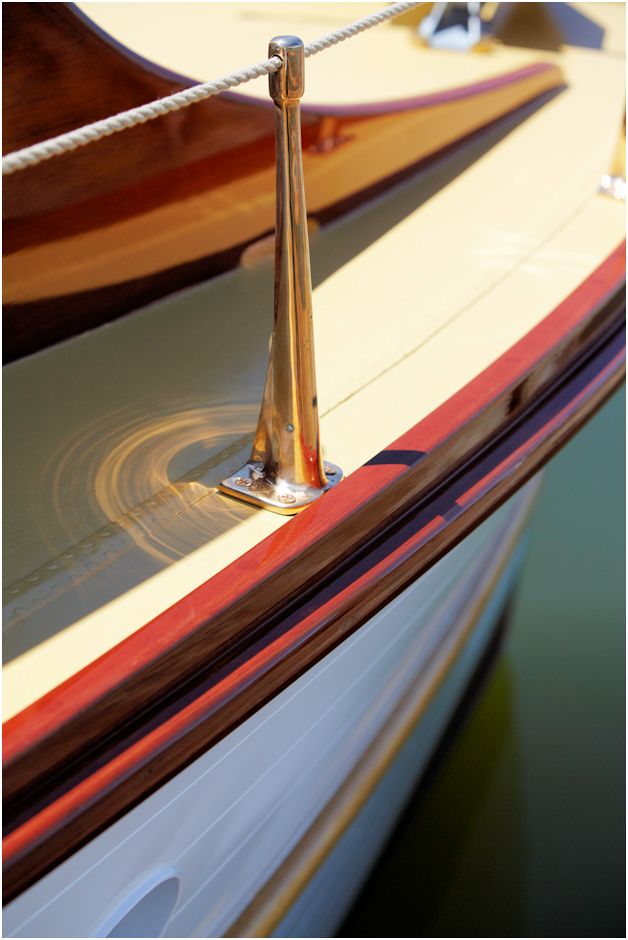
Anchor Light and some nice lines and cast bronze stanchion on Suellen.

Suellen Haskel Noland and great-granddaughter of the builder
[Photo from owner's collection.]
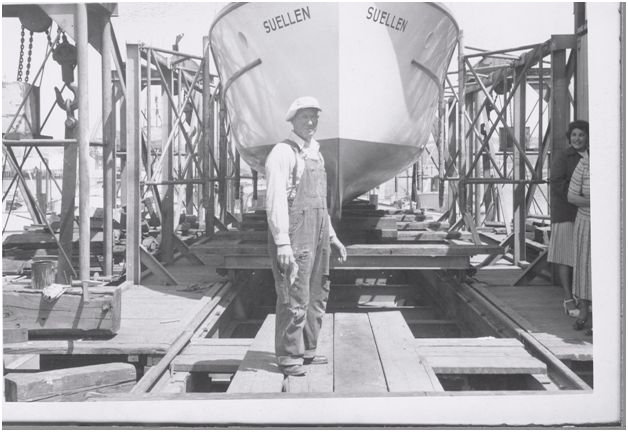
Builder Louis A. Hascall at the launch in 1951. [Photo from owner's collection.]

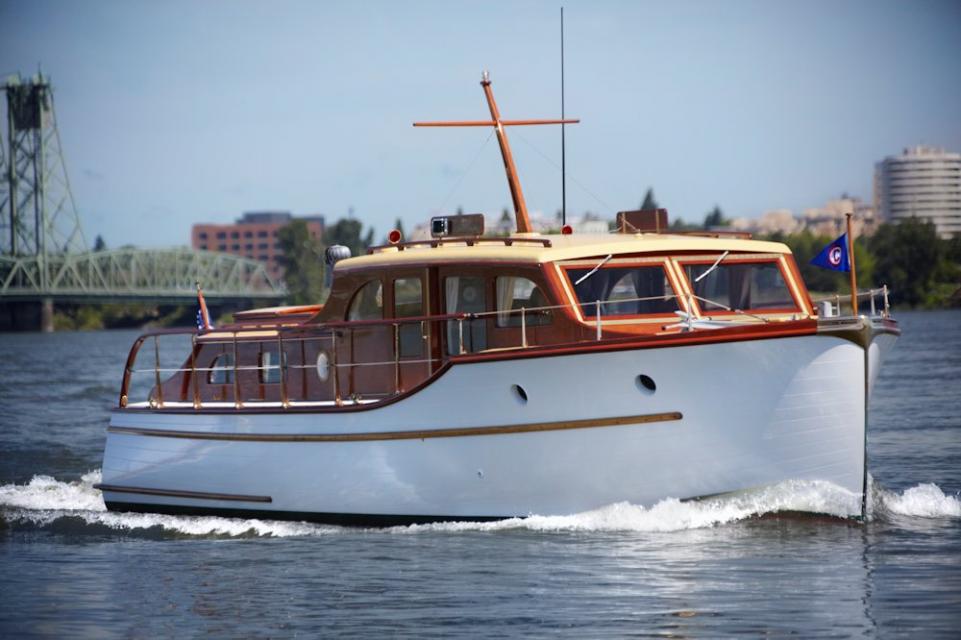

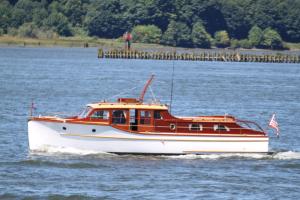
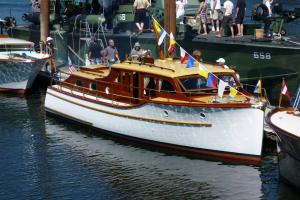

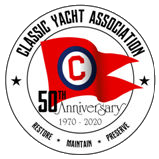 This yacht has been accepted and is currently registered as a Vintage vessel with the Classic Yacht Association.
This yacht has been accepted and is currently registered as a Vintage vessel with the Classic Yacht Association.